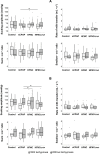Safety of Bottle-Feeding Under Nasal Respiratory Support in Preterm Lambs With and Without Tachypnoea
- PMID: 35046837
- PMCID: PMC8762202
- DOI: 10.3389/fphys.2021.785086
Safety of Bottle-Feeding Under Nasal Respiratory Support in Preterm Lambs With and Without Tachypnoea
Erratum in
-
Corrigendum: Safety of Bottle-Feeding Under Nasal Respiratory Support in Preterm Lambs With and Without Tachypnoea.Front Physiol. 2022 Feb 22;13:854173. doi: 10.3389/fphys.2022.854173. eCollection 2022. Front Physiol. 2022. PMID: 35283774 Free PMC article.
Abstract
Aim: Convalescing preterm infants often require non-invasive respiratory support, such as nasal continuous positive airway pressure or high-flow nasal cannulas. One challenging milestone for preterm infants is achieving full oral feeding. Some teams fear nasal respiratory support might disrupt sucking-swallowing-breathing coordination and induce severe cardiorespiratory events. The main objective of this study was to assess the safety of oral feeding of preterm lambs on nasal respiratory support, with or without tachypnoea. Methods: Sucking, swallowing and breathing functions, as well as electrocardiogram, oxygen haemoglobin saturation, arterial blood gases and videofluoroscopic swallowing study were recorded in 15 preterm lambs during bottle-feeding. Four randomly ordered conditions were studied: control, nasal continuous positive airway pressure (6 cmH2O), high-flow nasal cannulas (7 L•min-1), and high-flow nasal cannulas at 7 L•min-1 at a tracheal pressure of 6 cmH2O. The recordings were repeated on days 7-8 and 13-14 to assess the effect of maturation. Results: None of the respiratory support impaired the safety or efficiency of oral feeding, even with tachypnoea. No respiratory support systematically impacted sucking-swallowing-breathing coordination, with or without tachypnoea. No effect of maturation was found. Conclusion: This translational physiology study, uniquely conducted in a relevant animal model of preterm infant with respiratory impairment, shows that nasal respiratory support does not impact the safety or efficiency of bottle-feeding or sucking-swallowing-breathing coordination. These results suggest that clinical studies on bottle-feeding in preterm infants under nasal continuous positive airway pressure and/or high-flow nasal cannulas can be safely undertaken.
Keywords: lamb; non-invasive respiratory support; oral feeding; preterm; sucking–swallowing–breathing coordination.
Copyright © 2022 Elsewadi, Samson, Nadeau, Vanhaverbeke, Nguyen, Alain, Fortin-Pellerin and Praud.
Conflict of interest statement
The authors declare that the research was conducted in the absence of any commercial or financial relationships that could be construed as a potential conflict of interest.
Figures



References
LinkOut - more resources
Full Text Sources

